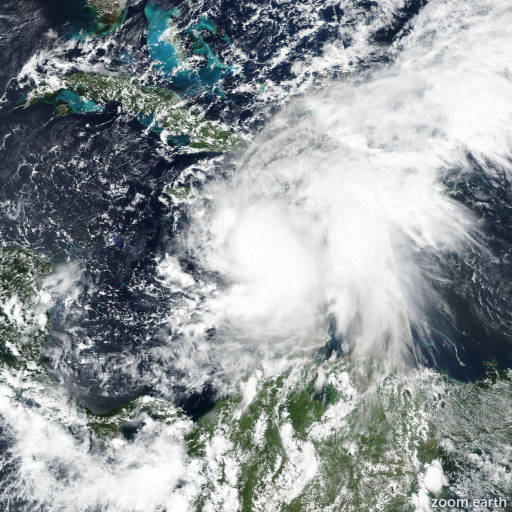Tropical Storm Melissa 2025
Last Modified:

Live tracking map, satellite images and forecasts of Tropical Storm Melissa 2025 in the Caribbean Sea. Current wind speed 70mph. Max 155mph.
Jamaica: Melissa’s slow movement will bring a multi-day period of damaging winds and heavy rainfall beginning late Saturday or Sunday, likely causing catastrophic flash flooding and numerous landslides. There is an increasing risk of life-threatening storm surge early next week. All preparations should be complete by late Saturday.
Haiti: Catastrophic flash flooding and landslides are expected across southwestern Haiti into early next week, likely causing extensive infrastructural damage and potentially prolonged isolation of communities. Immediate preparations to protect life and property are urged. Strong winds could also potentially last for a day or more over the Tiburon peninsula.
Dominican Republic: Heavy rainfall could produce potentially catastrophic flash flooding and numerous landslides in southern regions.
Eastern Cuba, Bahamas, and the Turks and Caicos: Monitor Melissa closely. There is an increasing risk of a significant storm storm surge, damaging winds, and heavy rainfall by the middle of next week. In eastern Cuba, the risk of life-threatening flash flooding and landslides is increasing.
Reports from NOAA and Air Force Reserve Hurricane Hunter aircraft indicate that Melissa is still trying to get organized. While the central pressure has fallen to 993 mb, the tail Doppler radar data from the NOAA aircraft shows that the 500-mb center is displaced about 20–25 nautical miles east-southeast of the surface center. The tilt is also present at the aircraft flight levels, with dropsondes released at the flight-level center missing the surface center and reporting 25–35 knots surface winds. In addition, the aircraft radar data and land-based radar data from Jamaica show that the cyclone has not yet been able to develop a persistent eyewall. Based mainly on the central pressure and satellite intensity estimates the initial intensity is held at 65 mph (55 knots).
Although the initial motion is a bit uncertain, Melissa now appears to be moving slowly northwest with the initial motion 325/3 knots. A turn toward the west or west-northwest and a continued slow forward speed are expected in 12–24 hours as low- to mid-level ridging builds to the north of the cyclone. This motion should continue through about 72 hours. After that time, a deep-layer mid-latitude trough moving into the southeastern United States and the southwestern Atlantic will break the ridge to the north, with Melissa expected to turn northward and eventually northeastward as it recurves into the westerlies. There remains a substantial spread in the guidance with respect to where the center of Melissa may pass in relation to Jamaica, with solutions ranging from the GFS passing near the eastern end of the island to the Canadian passing west of the island. The new forecast track is similar to the previous track and shows the center passing over Jamaica just after 72 hours. However, any motion north of the current forecast track could bring the center near or over Jamaica at almost any time between 24–72 hours. After passing Jamaica, Melissa is likely to move near or over eastern Cuba, but which portion of eastern Cuba may be most affected remains uncertain at this time.
While the westerly shear that has been affecting Melissa will not completely stop during the next 2–3 days, it is forecast to decrease to about 10–15 knots in 24 hours or less. This should allow rapid development as the storm is located in a moist environment over very warm sea surface temperatures. The one short-term restraining factor is that Melissa's structure is not quite good enough yet to allow rapid intensification (RI), and thus it could be another 6–12 hours before RI begins in earnest. The latest round of intensity guidance shows somewhat lower peak intensities than the previous advisory, mainly due to the models moving Melissa near or over Jamaica. However, the current forecast track keeps the center offshore for 72 hours or more, and based on this the new intensity forecast is at the high end of the guidance with a peak intensity of 155 mph (135 knots). Despite the weaker guidance, there is still a possibility that Melissa could become a category 5 hurricane during the forecast period. After passing near or over Jamaica, the cyclone is forecast to weaken due to possible interaction with Cuba and increasing southwesterly shear as Melissa encounters the mid-latitude westerlies.